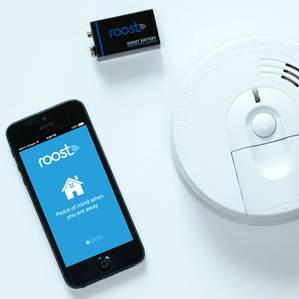Internet-Connected Battery Could Bring Smoke Alarms Online
A startup has come up with a simple way to make smoke and carbon-monoxide detectors more useful: a nine-volt battery with built-in Wi-Fi. The battery can alert you on your smartphone if the alarm goes off or the battery itself is about to die.

Roost, the Sunnyvale, California-based company behind the battery, plans to sell the batteries starting next year for $25 to $35.
“We were approaching the Internet-of-things space not from a perspective of ‘How can we build a whizzy new device that does something?’ but ‘What information do you have in the house that’s useful to you that you’d like access to when you’re not home?’ ” says cofounder and chief technology officer James Blackwell.
The idea could reach beyond alarms. Roost has its sights set on other devices, battery-powered and not, that are currently excluded from the growing throng of connected gadgets.
Roost’s first batteries, which are lithium-based and meant to last for more than five years, contain a Wi-Fi chip and sensors for audio detection and voltage monitoring. To get one working with a smoke alarm, you’d set it up with a forthcoming Roost smartphone app. Using the app, you can give a battery a name (like “living room” or “kids’ bedroom”), and connect it to your home Wi-Fi, and then insert it in the battery compartment of the alarm.
Right now, Roost has a working prototype in a plastic box about the size of an external hard drive; Blackwell expects a battery-sized version to be ready in the spring.
Roost plans to go beyond the nine-volt battery in the future—Blackwell says the company is thinking about AA batteries, since they’re commonly used in toys and remote controls. He’s also thinking about adding other sensors, such as an accelerometer or thermometer, to the battery.
Keep Reading
Most Popular
Large language models can do jaw-dropping things. But nobody knows exactly why.
And that's a problem. Figuring it out is one of the biggest scientific puzzles of our time and a crucial step towards controlling more powerful future models.
How scientists traced a mysterious covid case back to six toilets
When wastewater surveillance turns into a hunt for a single infected individual, the ethics get tricky.
The problem with plug-in hybrids? Their drivers.
Plug-in hybrids are often sold as a transition to EVs, but new data from Europe shows we’re still underestimating the emissions they produce.
Google DeepMind’s new generative model makes Super Mario–like games from scratch
Genie learns how to control games by watching hours and hours of video. It could help train next-gen robots too.
Stay connected
Get the latest updates from
MIT Technology Review
Discover special offers, top stories, upcoming events, and more.